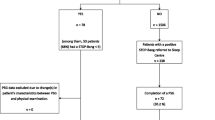Abstract
The aim of this study was to determine whether the 2-h daytime ApneaGraph (dAG) for patients with obstructive sleep apnea–hypopnea syndrome (OSAHS) can be used initially to diagnose and identify the site of obstruction before surgery. Fifty patients with OSAHS diagnosed by polysomnogram were enrolled in this prospective study. Sleep-related parameters, which include the indices for apnea–hypopnea (AHI), apnea index (AI), obstructive, central and mixed AHI (OAHI, CAHI and MAHI, respectively), the lowest oxygen saturation (LSaO2) and the proportion of upper and lower airway obstruction (UPPER and LOWER, respectively), were measured by both daytime and nocturnal AG (nAG). Different operative techniques were used according to the obstruction site assessed by the nAG. Clinical outcomes were assessed with the Epworth Sleepiness Scale (ESS), visual analog scale (VAS), AI, AHI and LSaO2. All the indices except LSaO2 found no significant differences between dAG and nAG; there were significant positive correlations with regard to most indices, but not for CAHI between dAG and nAG. When compared dAG with nAG, most moderate and severe patients had predominant sites of obstructions in the upper level. Postoperative ESS, VAS, AI and AHI decreased significantly, while LSaO2 significantly increased compared with those preoperative counterparts. dAG may be used as an alternative means for early and low-cost diagnostic evaluation of OSAHS before surgery.




Similar content being viewed by others
References
Shahar E, Whitney CW, Redline S, Lee ET, Newman AB et al (2001) Sleep-disordered breathing and cardiovascular disease: cross-sectional results of the Sleep Heart Health Study. Am J Respir Crit Care Med 163:5–6
Epstein LJ, Weiss JW (1998) Clinical consequences of obstructive sleep apnea. Semin Respir Crit Care Med 19:123–132
Conway W, Fujita S, Zorick F, Sicklesteel J, Roehrs T et al (1985) Uvulopalatopharyngoplasty: one-year follow up. Chest 88:385–387
Rollheim J, Tvinnereim M, Sitek J, osnes T (2001) Repeatability of sites of sleep-induced upper airway obstruction. A 2-night study based on recordings of airway pressure and flow. Eur Arch Otorhinolaryngol 258:259–264
Tvinnereim M, Miljeteig H (1992) Pressure recordings—a method for detecting site of upper airway obstruction in obstructive sleep apnea syndrome. Acta Otolaryngol Suppl 492S:132–140
Singh A, Al-Reefy H, Hewitt R, Kotecha B (2008) Evaluation of ApneaGraph in the diagnosis of sleep-related breathing disorders. Eur Arch Otorhinolaryngol 265:1489–1494
Shen P, Li WY, Huo H, Yang DH (2007) Comparison of diagnosis and localization methods in obstructive sleep apnea syndrome: apneagraph vs polysomnography and apneagraph vs endoscopy. Zhonghua Er Bi Yan Hou Tou Jing Wai Ke Za Zhi 42:612–618
Carsakadon M (1994) Principles and practice of sleep medicine. In: Kryger MH, Roth T, Dement WC (eds) Normal human sleep. WB Saunders, Philadelphia, pp 15–25
Hsu PP (2002) A new method of evaluation of upper airway in patients with obstructive sleep apnoea—computer-assisted quantitative videoendoscopic analysis. Ann Acad Med Singapore 31:393–398
Isono S, Shimada A, Tanaka A, Ishikawa T, Nishino T, Konno A (2003) Effects of uvulopalatopharyngoplasty on collapsibility of the retropalatal airway in patients with obstructive sleep apnea. Laryngoscope 113:362–367
Morales Divo C, Selivanova O, Mewes T, Gosepath J, Lippold R et al (2009) Polysomnography and ApneaGraph in patients with sleep-related breathing disorders. ORL J Otorhinolaryngol Relat Spec 71:27–31
Reda M, Gibson GJ, Wilson JA (2001) Pharyngoesophageal pressure monitoring in sleep apnea syndrome. Otolaryngol Head Neck Surg 125:324–331
Series F, Cormier Y, La Forge J (1991) Validity of diurnal sleep recording in the diagnosis of sleep apnea syndrome. Am Rev Respir Dis 143:947–949
Scharf SM, Garshick E, Brown R, Tishler PV, Tosteson T et al (1990) Screening for subclinical sleep-disordered breathing. Sleep 13:344–353
Van Keimpema ARJ, Rutgers SR, Strijers RL (1993) The value of one hour daytime sleep recording in the diagnosis of the sleep apnea syndrome. J Sleep Res 2:257–259
Guilleminault C, Rosekind M (1981) The arousal threshold: sleep deprivation, sleep fragmentation, and obstructive sleep apnea syndrome. Bull Eur Physiopathol Respir 17:341–349
Woodson BT, Wooten MR (1992) A multisensory solid-state pressure manometer to identify the level of collapse in obstructive sleep apnea. Otolaryngol Head Neck Surg 107:651–656
Chesson AL Jr, Ferber RA, Fry JM, Grigg-Damberger M, Hartse KM et al (1997) Practice parameters for the indications for polysomnography and related procedures. Sleep 20:406–422
Tvinnereim M, Mitic S, Hansen RK (2007) Plasma radiofrequency preceded by pressure recording enhances success for treating sleep-related breathing disorders. Laryngoscope 117:731–736
World Health Organization. The World Health Report (2000) Health systems: improving performance. World Health Organization, Geneva
Miyata S, Noda A, Nakata S, Yagi H, Yanagi E et al (2007) Daytime polysomnography for early diagnosis and treatment of patients with suspected sleep-disordered breathing. Sleep Breath 11:109–115
Battagel JM, Johal A, Smith AM, Kotecha B (2002) Postural variation in oropharyngeal dimensions in subjects with sleep disordered breathing: a cephalometric study. Eur J Orthod 24:263–276
Faber CE, Grymer L (2003) Available techniques for objective assessment of upper airway narrowing in snoring and sleep apnea. Sleep Breath 7:77–86
Conflict of interest
None.
Author information
Authors and Affiliations
Corresponding author
Rights and permissions
About this article
Cite this article
Yu, R., Li, W., Huo, H. et al. Short daytime ApneaGraph for initial case selection of obstructive sleep apnea–hypopnea syndrome before surgery. Eur Arch Otorhinolaryngol 268, 1663–1669 (2011). https://doi.org/10.1007/s00405-011-1564-4
Received:
Accepted:
Published:
Issue Date:
DOI: https://doi.org/10.1007/s00405-011-1564-4




